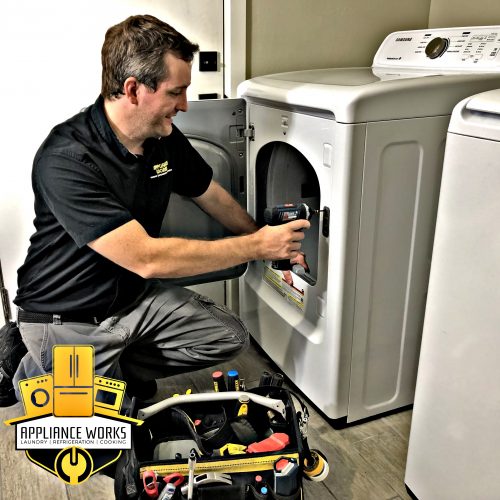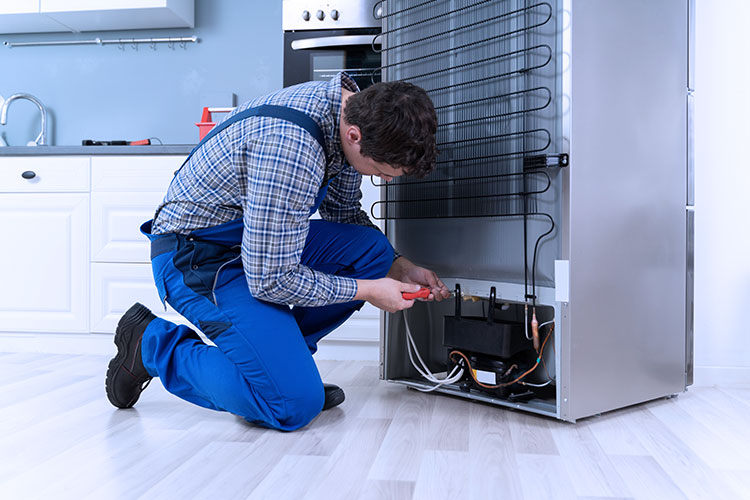The Top Reason to Call Emergency Sub-Zero Repair Dependable Refrigeration & Appliance Repair Service for Urgent Fixes
The Top Reason to Call Emergency Sub-Zero Repair Dependable Refrigeration & Appliance Repair Service for Urgent Fixes
Blog Article
The Ultimate Overview to DIY Device Fixing Methods
When home appliances damage down, it's simple to really feel overwhelmed. Emergency Sub-Zero Repair Dependable Refrigeration & Appliance Repair Service. However with the ideal expertise and devices, you can tackle typical concerns yourself. From fridges to dish washers, comprehending exactly how to repair and repair these devices can save you time and cash. Are you all set to discover necessary techniques that will empower you to manage repairs confidently? Allow's discover the key areas where DIY skills can make a substantial difference.
Recognizing Common Home Appliance Problems
When you count on your home devices, it can be irritating when they instantly quit working or break down. Recognizing typical appliance issues can assist you repair concerns successfully. If your fridge isn't cooling, inspect the temperature settings or examine the door seal for voids. A defective washing machine may be due to a stopped up drain filter or a damaged belt.
If your stove isn't heating, defective components or thermostat issues might be at fault. Dishwashers commonly experience issues with water drainage, so see to it the filter is clean and the drain tube isn't kinked.
Also, pay attention for unusual sounds; they usually suggest mechanical issues. By acknowledging these signs, you can conserve time and potentially prevent pricey repair services. A little knowledge goes a lengthy method in keeping your devices, so stay educated to keep whatever running smoothly.
Necessary Tools for Do It Yourself Repairs
Prior to diving right into DIY device fixings, it's vital to gather the right tools to ensure the procedure goes smoothly. Begin with a good set of screwdrivers, consisting of both flathead and Phillips, as they're vital for opening up most home appliances. You'll additionally want a pair of pliers for grasping and twisting wires or tiny elements.
Do not forget a multimeter; it helps you test electric components and diagnose problems properly. A socket collection is convenient for loosening or tightening screws, while an utility knife can be helpful for opening up or cutting wires product packaging.
Ultimately, consider having a flashlight on hand to light up dark areas inside your appliances. With these essential tools, you'll be well-equipped to take on numerous repairs, saving both money and time. Collect your equipment and get ready to roll up your sleeves!
Security First: Safety Measures to Take
Before you begin any kind of device fixing, it's essential to focus on security. Make sure you use individual protective tools, disconnect the source of power, and maintain your job area organized. These easy safety measures can help avoid accidents and assure a smoother fixing procedure.

Individual Safety Tools
Safety and security equipment is an essential component of any type of DIY device repair service project. Steel-toed boots are also a smart selection, particularly when lifting hefty home appliances. Remember, being prepared with the appropriate equipment keeps you secure and concentrated on completing your fixing effectively.
Source Of Power Interference
To ensure a safe do it yourself home appliance repair, detaching the power source is important. Prior to you begin any type of work, you must turn or disconnect the home appliance off the circuit breaker. This straightforward step protects against electric shocks and warranties that you can concentrate on the repair service without worrying concerning unintentional activation. Constantly double-check that the home appliance is off by testing it with a voltage tester. If you're taking care of larger home appliances, like a washer or dryer, make certain to secure the power cord and prevent any kind of contact with water. Bear in mind, safety and security initially! When you're certain that the power is disconnected, you can confidently proceed with your repair work, recognizing you've taken the needed preventative measures to protect yourself.
Workspace Organization
An efficient workspace can make all the distinction in your DIY home appliance repair job. Start by clearing your work area of mess to avoid disturbances and mishaps. Set out all your materials and devices, organizing similar items with each other for very easy access. Make use of a tool kit or organizer to keep tiny components like washing machines and screws had and classified. See to it you've obtained ample illumination; it'll assist you see details plainly and lower the danger of mistakes. Do not neglect to keep safety equipment like gloves and safety glasses accessible. Lastly, have a trash can helpful to take care of waste without delay. A neat space not just increases performance however also keeps you secure while you function on your appliance fixing.
Step-by-Step Guide for Fridge Services
When your refrigerator begins breaking down, it can be discouraging, yet tackling the issue on your own can save you money and time. Unplug the fridge to assure safety and security. Look for typical concerns like temperature changes or uncommon noises. Check the thermostat setups; they could be set as well high if it's not cooling down. Next off, tidy the condenser coils, which commonly accumulate dirt and particles. For a noisy fridge, examine the follower and verify it's not blocked.
If there's water merging within, evaluate the door seals for damages or dust, and clean them if needed. For ice build-up, clear the defrost drain. When you've attended to the problem, plug the fridge back in and check it for a couple of hours. If the trouble lingers, you might require to replace a malfunctioning component, like the compressor or fan motor. Keep in mind, do not think twice to consult the manual or seek expert help if required.
Repairing Washing Machine Concerns
Simply like fridges, washing machines can provide their very own collection of obstacles, yet several concerns can be solved with a little bit of troubleshooting. If your equipment will not begin, check the power cable and validate it's connected in.
If your clothes aren't obtaining clean, consider the water degree and cleaning agent kind; making use of also much cleaning agent can develop excess suds, impacting efficiency. For leaks, take a look at the pipes for fractures or loose connections. Tightening these can frequently fix the issue. Routine continue reading this maintenance, like cleaning the filter, can protect against several concerns from emerging. Bear in mind, a little troubleshooting goes a lengthy method in keeping your washing machine running efficiently.
Fixing Cooktops and stoves
Exactly how can you troubleshoot usual problems with your oven or stove? Start by examining the power supply. Ensure it's plugged in and the breaker is not tripped. If it's a gas stove, validate the gas valve is open. Next, examination the heaters: if they do not ignite, clean up the igniter and look for clogs in the heater ports.
If your stove isn't home heating, inspect the temperature level settings and confirm the door seals securely. If it's damaged., a faulty home heating component can additionally be the perpetrator; you may need to replace it.
For unequal food preparation, turn your frying pans and consider utilizing an oven thermostat to verify accurate temperature levels. If you listen to unusual noises or scent gas, transform off the device quickly and consult an expert. By following these actions, you can determine and solve several common oven and range concerns successfully.
Repairing Dishwashers Facilitated
When your dishwashing machine begins breaking down, it can be discouraging, but attending to usual concerns isn't as difficult as it appears. You'll find out detailed troubleshooting techniques that will aid you pinpoint the problem, along with the vital devices you'll need to deal with repair services on your own. Let's make fixing your dishwasher a wind!
Usual Dishwashing Machine Concerns
While dishwashing machines are designed to make your life easier, they can sometimes face common concerns that leave you really feeling frustrated. One frequent problem is inadequate cleansing performance; this typically occurs due to clogged spray arms or unclean filters. You might also observe water pooling at the bottom, which can suggest a kinked tube or a faulty drain. If your dishwashing machine's door won't latch, it can be a straightforward problem with the latch mechanism or door seal. Additionally, weird noises can indicate worn-out parts or loose components. check If you smell something weird, it may be time to examine for food debris or a malfunctioning electric motor. Resolving these problems early can conserve you time and headache down the road (Emergency Sub-Zero Repair Dependable Refrigeration & Appliance Repair Service).

Detailed Troubleshooting
Prior to diving into fixings, it's vital to identify the particular issue your dishwashing machine is encountering. If your dish washer will not begin, inspect the power supply and door lock. By systematically attending to each prospective problem, you can determine the issue and take the necessary actions to repair it, making your dish washer feature like new once again.
Necessary Fixing Tools
Having the right devices at your disposal can make all the difference when fixing your dish washer. Do not fail to remember a bucket or towels for any kind of water spills throughout repair services.
If you're dealing with clogs, a drainpipe snake or a wet/dry vacuum cleaner will certainly be vital. You might additionally desire a level to ensure your dishwasher's effectively lined up. Safety equipment like handwear covers and safety glasses will secure you while you work. With these crucial tools, you'll be well-appointed to deal with any dishwashing machine repair difficulty that comes your way.
Often Asked Inquiries
Exactly how Do I Determine if a Home Appliance Is Well Worth Fixing?
To establish if an appliance's worth repairing, consider its age, repair service prices, and current value. If repair services go beyond half the substitute cost, you might intend to buy a brand-new version rather.
Can I Discover Replacement Parts Locally for My Device?
Yes, you can often find replacement components in your area for your home appliance. Inspect hardware shops, home appliance service center, or local classifieds. Do not neglect to bring the design number to ensure you get the correct component!
What Usual Mistakes Should I Prevent When Repairing Devices?
When repairing devices, prevent rushing via diagnostics, overlooking security precautions, or making use of wrong tools. Don't avoid reading guidebooks or enjoying tutorials; they provide essential support. Be client and extensive to guarantee great site successful repairs and stop more damage.
Just how Long Does a Typical DIY Appliance Repair Service Take?
A normal do it yourself home appliance repair work generally takes one to three hours, relying on the complexity. You'll desire to collect your tools and products initially, and adhere to directions carefully to prevent unneeded delays.
Are There Any Kind Of Warranties for DIY Appliance Fixes?
When you take on DIY home appliance fixings, guarantees typically don't cover your job. Nonetheless, some producers could honor guarantees for components you change. Constantly examine your appliance's guarantee terms prior to beginning any kind of repairs to avoid issues.
Before diving into DIY home appliance fixings, it's vital to gather the right tools to guarantee the process goes smoothly.Before you start any type of home appliance repair work, it's important to prioritize security.To assure a secure Do it yourself home appliance repair work, disconnecting the power resource is essential.An efficient work area can make all the distinction in your DIY device repair work job. Always inspect your home appliance's guarantee terms prior to beginning any kind of repairs to stay clear of concerns.
Report this page